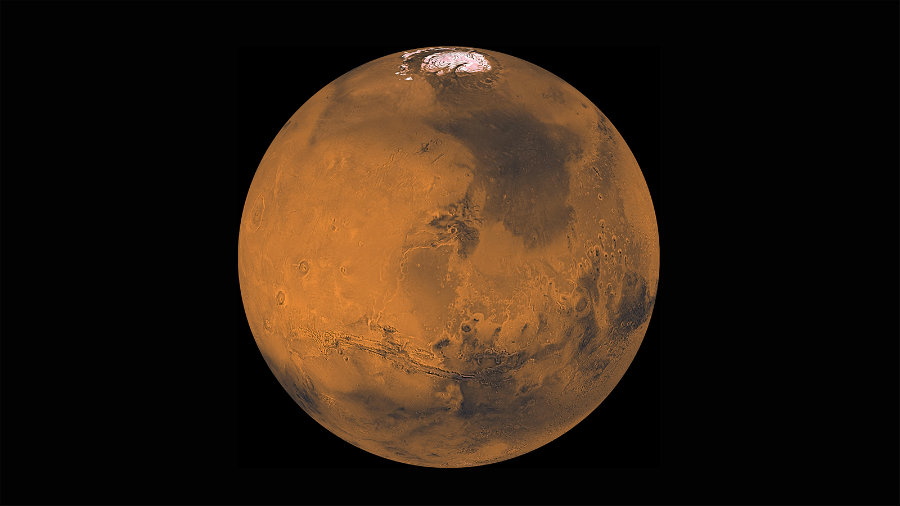Beijing – As part of their ambitious space program, China has unveiled to the world its latest development in space exploration: a rover to Mars.
The Chinese are aiming to launch the rover toward the red planet somewhere around July or August of 2020, according to the chief architect of this project, Zhang Rongquiao, reports the Xinhua news agency, who also stated they are facing “unprecedented challenges.” This would be the second rover deployed by China, with the first being sent to the moon in late 2013.

In spite of mechanical difficulties, the rover exceeded expectations and was shut down just earlier this month, after a bit less than three years of operation on the surface of the moon.
The Chinese project
This new Mars rover is expected to explore the surface of the planet for approximately three months or ninety-two days.
Reports from the state news agency Xinhua give the characteristics of the rover in higher detail, indicating that it is set to weight 200 kilograms (or 441 pounds). This would make the robot 60 kilograms heavier than the moon rover of 2013 — and is equipped with six wheels and four solar panels for power.
The rover will get to the red planet in a space probe, which carries thirteen payloads. Among those described are a remote sensing camera and ground penetrating radar, which will study the surface of Mars, including its inner structure, and look for traces of water and ice.
A new space race has started, this time for Mars
China hopes to catch up with the United States and various European nations in space development, wanting to establish itself as a “space power.”
In 2003, China became the third country to put a man in space, after the US and Russia. So far, the nation’s very expensive space program is seen as a testament to the progress in the country.

However, China is not the first to send rovers to Mars. NASA successfully sent the Sojourner, which landed on July 4, 1997, the Spirit that reached Mars on January 4, 2004, the Opportunity that landed on January 25, 2004, and the Curiosity which arrived on August 6, 2012, to the red planet.
And before NASA did it, the Soviet Union tried to deploy their Prop-M rovers on the Earth’s closest neighbor back in 1971. Although one probe crashed, and the other lost communication within 20 seconds of landing.
After the Sojourner, the European Space Agency sent their Beagle 2 spacecraft with a Planetary Undersurface Tool, a robot that would be able to burrow into Mars’ surface. Nonetheless, the rover failed to deploy because of lost communication, in spite of successful landing.
It’s also worth noting that India successfully put a probe into Mars’s orbit back in September 2014. China had attempted a similar thing in 2011. However, this attempt failed when the rocket with the payload failed to get out of Earth’s orbit.
Not everyone shares China’s excitement about the rover. The United States Defense Department says the nation is looking to prevent adversaries from using space assets in a crisis. Nonetheless, China insists that the program is for peaceful purposes.
Before this announcement, the United States’ Congress had denied NASA from working alongside China’s aeronautical administration because of security concerns, and Beijing has tested missiles with anti-satellite capabilities.
A brief history of rovers
A rover is a space exploration vehicle designed to explore the surface of planets and collect information about them. This includes collecting samples and taking pictures.
The very first was set to be the Soviet Lunokhod 0 (No. 201), but a failed launcher that started on February 19, 1969, ended that plan.
It was not until a year after that the first successful one landed on the Moon in November 1970, also a Soviet invention, named Lunokhod 1.
It held the record as the most durable rover for 30 years until the arrival of the Mars Exploration Rovers. NASA also sent its rovers along during three Apollo missions (15, 16 and 17).
From there on comes the Lunokhod 2, the never deployed Prop-M rovers, the Lunokhod 3, which was built, but its mission was canceled, the failed Marsokhod, the Sojourner, the Beagle 2 Planetary Undersurface Tool, and the Mars exploration rover, Spirit.
About Earth’s neighboring planet, Mars
Named after the Roman God of War, and nicknamed the red planet because of its color, which is given by the abundant iron oxide on its surface, Mars has been subject to ongoing investigations regarding its habitability.
There is evidence that it used to be more habitable in the past, but it remains unknown whenever or not there ever were living organisms on its surface.
Observations by spacecraft reveal the possibility of flowing water during the warmer months on the planet, and that Mars’ soil contains between 1.5 and 3 percent of water by mass attached to other compounds.
Source: Independent
